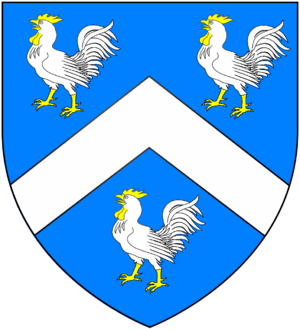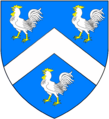Sampson Lloyd (iron manufacturer) facts for kids
Quick facts for kids
Sampson Lloyd
|
|
|---|---|

Arms of Lloyd of Dolobran, Montgomeryshire, Wales (of which family were the Lloyd Quakers, bankers and steel manufacturers of Birmingham and Baron Lloyd of Dolobran: Azure, a chevron between three cocks argent armed crested and wattled or)
|
|
| Born | 1664 Welshpool, Wales
|
| Died | 3 January 1724 (aged 59–60) |
| Occupation | Ironmonger |
| Known for | Founding the Lloyd family of Birmingham |
| Spouse(s) |
Elizabeth Good
(died 1692)Mary Crowley
(m. 1695) |
| Children | 10, including Sampson Lloyd II |
| Relatives |
|
Sampson Lloyd (1664 – 1724) was an important Welsh businessman. He made iron products in Birmingham, England. He started a famous family business that later founded Lloyds Bank. Today, Lloyds Bank is one of the biggest banks in the United Kingdom.
Contents
Who Was Sampson Lloyd?
Sampson Lloyd was born in 1664 in Welshpool, Wales. His family, the Lloyds of Dolobran, had lived there for many years. His father was Charles Lloyd, and his mother was Elizabeth Lort.
Why Were His Parents Under House Arrest?
Sampson's parents were Quakers. Quakers are a religious group who believe in peace and do not swear oaths. At that time, the government made people take an Oath of Allegiance to King Charles II. Because Sampson's parents refused to take this oath, they were held under house arrest. This meant they could not leave their rented home in Welshpool for many years. Sampson was born while they were under this house arrest.
Sampson Lloyd's Business Journey
Sampson Lloyd followed his family's Quaker faith. When he was 34, in 1698, he decided to leave Wales. He moved to Birmingham, a town about 62 miles away. Birmingham was a good place for Quakers and other religious groups. They could practice their faith freely there.
Why Birmingham Was a Good Choice
Birmingham was special because it didn't have strict rules for businesses. This made it easy for people like Sampson to start new factories or shops. He quickly found ways to use his energy and money. He became an ironmaster, someone who makes and sells iron.
What Was a Slitting Mill?
Sampson started an iron business and built a slitting mill in Birmingham. This mill was on the bank of the River Rea. A slitting mill used water power to cut large sheets of iron into smaller pieces. These smaller pieces were then used to make nails.
Here's how a slitting mill worked:
- First, a large iron bar was cut into foot-long pieces using huge shears. These shears were powered by a water-wheel.
- Next, the pieces were heated until they were red-hot in a furnace.
- Then, they were put between steel rollers. These rollers stretched the iron into long, thin strips.
- Finally, the strips went through another set of rollers. These rollers had sharp edges, like scissors. They cut the strips into many square rods.
- Once cool, these rods were bundled up and sold to nail makers.
Sampson also opened a shop in Edgbaston Street, Birmingham, where he sold iron. His company, "Sampson Lloyd and Sons," became very successful.
Sampson Lloyd's Family Life
Sampson Lloyd was married twice. His first wife was Elizabeth Good. They had four daughters together. After Elizabeth passed away, he married Mary Crowley in 1695. Mary's father, Ambrose Crowley, was also a Quaker and a blacksmith. He was a very important businessman.
Sampson and Mary had six children, including four sons and two daughters. One of their sons was Sampson Lloyd II (1699–1779). This son later helped start Lloyds Bank, which grew into the large bank we know today.
Where Did Sampson Lloyd Live?
Sampson Lloyd owned a large house at 56 Edgbaston Street in Birmingham. He also had other properties, including some in Stourbridge and a home near Leominster in Herefordshire.
When Did Sampson Lloyd Die?
Sampson Lloyd passed away on January 3, 1724, when he was 60 years old. His wife, his son Sampson II, and other family members helped manage his business and property after his death.
Images for kids


